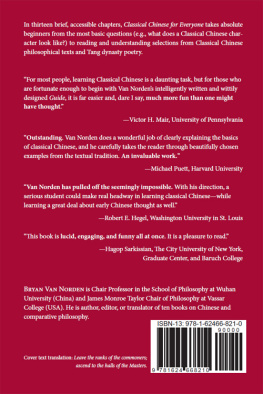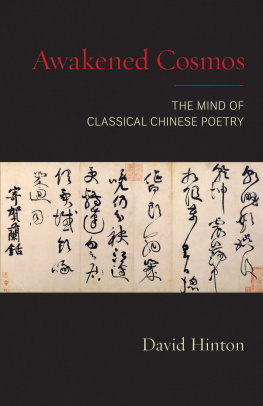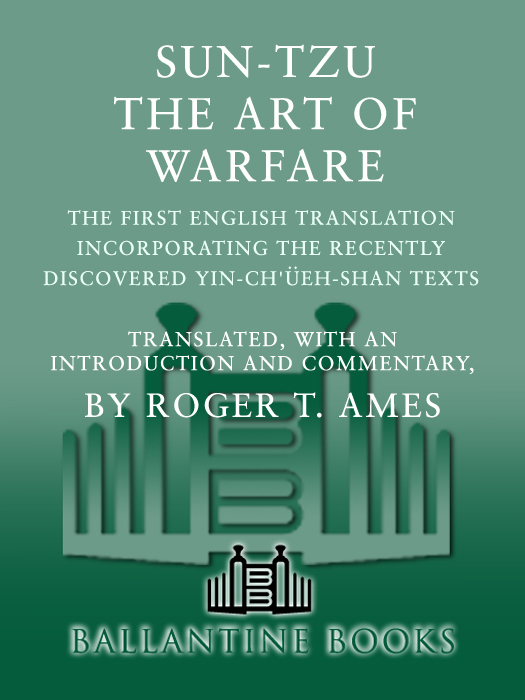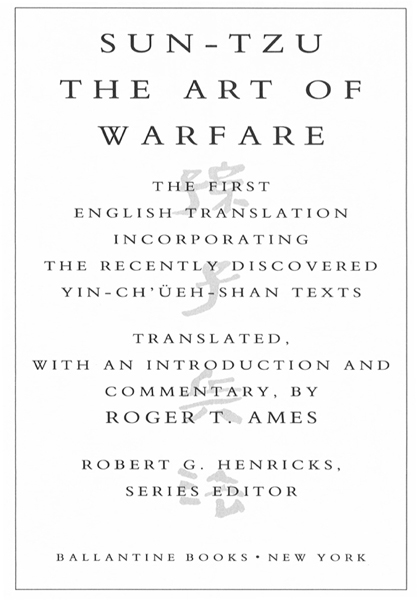ACKNOWLEDGMENTS
These are exciting days for the study of classical China. Over the past few decades, students of early China, encouraged by the continuing discovery of textual materials lost for millennia, have been working to bring this culturally formative period into sharper focus.
Owen Lock, a China specialist and also editor-in-chief of Del Rey Books (an imprint of Ballantine Books), has followed these developments closely, and has been keenly aware of their significance for understanding the cultural origins of the longest continuous civilization in human history. Classics of Ancient China, the series of which this volume, Sun-tzu: The Art of Warfare, is a part, has been created by Owen as a means of bringing this revolution to the attention of a broad reading public. His careful attention to this book at every stage, his detailed comments on draft manuscripts, and his informed enthusiasm for the subject itself have made the project enjoyable and exciting from the outset, and I am most grateful to him.
Robert G. Henricks, with his translation of Lao-tzu: Te-tao ching, inaugurated this series, and by the sustained quality of his scholarship has set a high standard for us all. He, like Owen, read the manuscript, and gave me comments that have made it a better book. I have relied on another author in our series, Robin D. S. Yates, who has been ever generous with his advice on military technology.
In Beijing, I benefited from personal conversations and from the important publications of Wu Jiulong (Wu Chiu-lung) and Li Ling. In Shenyang, the consummate scholar Zhang Zhenze (Chang Chen-tse) shared his work and his warmth.
I would also like to thank Tian Chenshan of the Center for Chinese Studies at the University of Hawaii, who worked closely with me on the preparation of the critical Chinese text. Several of my colleagues gave their time and their thoughts in reading different generations of the manuscript: I am grateful to Michael Speidel, Tao Tien-yi, Elizabeth Buck, and Daniel Cole.
The Chuang-tzu tells us that none of us walks alone; each of us is a crowd, a field of selves. D. C. Lau, Angus Graham, Yang Yu-wei, Eliot Deutsch, David L. Hall, Henry Rosemont, Jr., and Graham Parkesand my family: Bonnie, Jason, Austin, and Cliffhave all crowded around as I collected myself and did this work, and I have spent a lot of time with each of them. If an expression of gratitude could ever be at once sincere and selfish, it is so for me on this occasion.
Roger T. Ames
Honolulu
CONTENTS
The Classical Chinese World View:
The Uncommon Assumptions
Some Classical Western Assumptions:
A Two-World Theory
Some Classical Chinese Assumptions:
A This-World View
Sun-tzu: Part I
The Thirteen-Chapter Text
Sun-tzu: Part II
Text Recovered from the Yin-cheh-shan Han Dynasty Strips
Sun-tzu: Part III
Text Recovered from Later Works
INTRODUCTION
THE NEW SUN-TZU
The Sun-tzu, or Master Sun, is the longest existing and most widely studied military classic in human history. Quite appropriately, it dates back to the Warring States period (c. 403-221 B.C .), a formative phase in Chinese civilization when contributions in literature and philosophy were rivaled in magnitude and sophistication only by developments in an increasingly efficient military culture.
Over the course of the preceding Spring and Autumn period (c. 722-481 B.C .), scores of small, semiautonomous states had joined in an ongoing war of survival, leaving in its wake only the dozen or so central states (chung-kuo) from which present-day China takes its actual Chinese-language name. By the fifth century B.C ., it had become clear to all contenders that the only alternative to winning was to perish. And as these rivals for the throne of a unified China grew fewer, the stakes and the brutality of warfare increased exponentially.
During this period, warfare was transformed from a gentlemanly art to an industry, and lives lost on the killing fields climbed to numbers in the hundreds of thousands. Itinerant philosophers toured the central states of China, offering their advice and services to the contesting ruling families. Along with the Confucian, Mohist, and the Legalist philosophers who joined this tour was a new breed of military specialists schooled in the concrete tactics and strategies of waging effective warfare. Of these military experts, history has remembered best a man named Sun Wu from the state of Wu, known honorifically as Sun-tzu or Master Sun.
A major reason why Master Sun has remained such a prominent force in the military arts is the military treatise Sun-tzu: The Art of Warfare (Sun-tzu ping-fa), that came to be associated with his name early in the tradition. Over the centuries, a library of commentaries has accrued around the text, and it has been translated into many, if not most, of the worlds major languages.
Although there are several popular English translations of the Sun-tzu, several of which are discussed below, there are reasons why a new translation and study of the text is necessary at this time. The Sun-tzu offered here in this Classics of Ancient China series differs markedly from previous editions in several important respects.
In 1972 a new text of the Sun-tzu was uncovered in an archaeological find in Shantung province, containing not only large sections of the thirteen-chapter work that has come down to the present day, but also portions of five lost chapters of the Sun-tzu. All of these materials, previously unavailable to the student of the Sun-tzu text, were entombed as burial items sometime between 140 and 118 B.C .
This archaeological discovery means several things.
The English translation of the thirteen-chapter core text contained in and which in length are about 20 percent of the thirteen-chapter core text, are entirely new, and provide us with additional insights into both the content and the structure of the original text.
authentic. One factor that had previously brought these materials into question was a difference in style: The thirteen-chapter text is narrative prose while the encyclopedic citations are, by and large, in dialogue form. Now that we have confirmed outer commentarial chapters of the Sun-tzu that are also structured as dialogues and that share many stylistic features with the encyclopedic citations, our reasons for being suspicious are less compelling. Although the authenticity of any one of these passages is still impossible to determine, the general correspondence between passages found in the reconstructed Sun-tzu and those preserved in the encyclopedias suggest that many of the citations might well be from the lost portions of this text.
I also have included in a few fragments from a 1978 archaeological find in Ching-hai province dating from the first or second centuries B.C . Six of the strips uncovered refer explicitly to Master Sun, suggesting some relationship with the Sun-tzu











